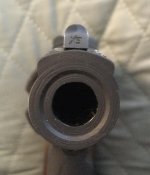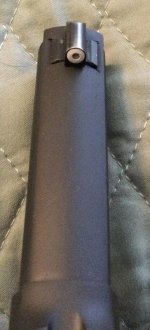No argument, but my concern, the factor I'm hung up on is the time element. The gas pressure (the force) created by the burning powder starts to build when the powder is ignited. It goes from zero to a bunch within a very short (but real) amount of time (and I will argue about the use of the term "explosion"----given the use of smokeless powder). The bullet starts to move before the force is at its maximum----and the force stops pushing on the bullet at the muzzle of the gun. Not very long after the force stops pushing on the bullet, it gives every appearance of pushing on the gun a whole bunch------------if I may liken the muzzle blast to the exhaust of a rocket/jet engine----and interject the topic of thrust---acting against the atmosphere-----and the gun----which moves a little or a lot as you noted-------depending on the nature of the load and the weight of the gun.
So, here we are once again talking about force and mass, and the time it takes a force to accelerate two different objects------a bullet on the one hand, and a gun on the other hand. We speak of bullet weight in grains. We speak of gun weight in pounds and ounces. If we were to speak of a typical bullet fired from a K-38, we'd speak of a 148 grain wadcutter. If we were to speak of a K-38 (which weighed 2.2lbs on my not legal for trade scale) in the same terminology, we'd speak of a 15,400 grain gun. And as you noted, the heavier it is, the more energy it takes to get it moving. And as I noted (or perhaps am about to), given equal energy acting on a comparatively light weight object and a comparatively heavy weight object, the more time it takes to get it moving--------which is about where I came in.
Now, can I demonstrate this with an irrefutable mathematical formula (as I've been hoping someone here would step up and do)? Nope---not a chance! And that's because the most complicated mathematics course I had in high school was plane geometry---and in college was algebra and trigonometry (and only because both were required for graduation). I made it through trigonometry by memorizing the material to be treated on interim examinations, and went into the final (in the last semester of my senior year---having put off the trig for as long as I could) with a solid A. I talked myself out of taking the final because the instructor was overly impressed with my membership on the Dean's List, and because I told a monstrous fib about an out of town job opening dependent upon starting before the trig final--------and the fact I was willing (thankful) to take a C as a final grade in the course. (Where there's a will, there's a way-----sure enough!!)
My bottom line which I am unable to demonstrate with irrefutable, scientific precision (other than to speak of photographs of bullets in the air while their launch vehicles (clearly visible in the same photos) shows no sign of movement whatsoever----that and a long ago conversation with an engineer from Remington) is the bullet is long gone from the barrel of the gun before there is any movement of the gun caused by recoil whatsoever. And yes, I am acutely aware of the legions who do not share my belief.
Ralph Tremaine








